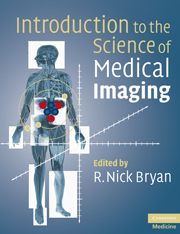8 - Optical imaging
Published online by Cambridge University Press: 01 March 2011
Summary
Optical imaging is a ubiquitous component of biomedical research because of the applicability of fluorescent and bioluminescent proteins to a virtually infinite number of experimental assays. Green fluorescent protein (GFP), for example, can be used for tracing cell migration and protein localization, quantifying reporter gene expression and monitoring tumor growth in vivo, among other uses. Osamu Shimomura, Martin Chalfie, and Roger Tsien were awarded the 2008 Nobel Prize in Chemistry for their discovery and development of GFP, a contribution that has benefited all fields of biology and medicine. In the sections that follow, we discuss the natural origin and principles of bioluminescence and fluorescence, and provide examples of their application in the field of cancer research.
Bioluminescence: a historical perspective
Numerous organisms are bioluminescent or, by definition, emit light. Bioluminescent species evolved independently at least 30 times, which is evident from the lack of homology in light-producing enzymes (luciferases) and the chemical diversity of their substrates (luciferins), highlighting the evolutionary importance of this trait. The luminescence of bacteria, fungi, squid, and fish is thought to serve diverse biological functions. The firefly uses luminescent signaling to communicate with potential mates and the scale worm evades predators by producing and shedding a luminous epithelial layer that serves as a glowing decoy. The study of these intriguing behaviors has led to the identification of light-producing proteins, luciferase and GFP, which are now cornerstones of optical imaging.
Information
- Type
- Chapter
- Information
- Introduction to the Science of Medical Imaging , pp. 172 - 182Publisher: Cambridge University PressPrint publication year: 2009
